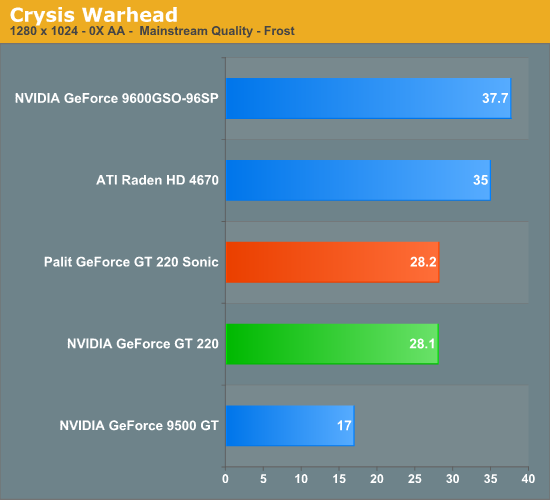NVIDIA’s GeForce GT 220: 40nm and DX10.1 for the Low-End
by Ryan Smith on October 12, 2009 6:00 AM EST- Posted in
- GPUs
Crysis: Warhead
Kicking things off, we’ll start with Crysis: Warhead. Warhead is still the single most demanding game in our arsenal, with even high-end cards continuing to struggle to put out a playable frame rate with everything turned up.
For testing these low-end cards, we have deviated some from our normal testing. These tests were done with Mainstream graphics quality at resolutions more appropriate for these cards.


The last card we ended up testing for this article was the 4670, and the moment we ran this benchmark it basically killed any enthusiasm we had for the GT 220. The GT 220 is not competitive here with the 4670, which is its slightly cheaper competition from AMD.
If there is a bright side, Crysis does run decently even on the GT 220 after turning down the quality settings to Mainstream.










80 Comments
View All Comments
chizow - Monday, October 12, 2009 - link
Is this the one you're referring to Ryan?http://www.newegg.com/Product/Product.aspx?Item=N8...">http://www.newegg.com/Product/Product.a...E1681412...
From all reports and feedback I've seen, that Asus part is 96SP for $40 AR (was actually $35 at one point!) just as Ben stated.
I don't really care about this segment of parts for actual 3D so you may be right. I was only interested in that Asus 96SP because it was identified by many users as "the card" to get for dedicated PhysX on a budget. I was hoping to find a low-power consumption candidate on 40nm for dedicated PhysX, but it seems these parts have too few SP to be viable.
BenSkywalker - Monday, October 12, 2009 - link
Why not include benches of the nV part that you quoted the price for then(btw- NewEgg is also listing one of the 384MB 96SP 9600GSOs for $56.49)?It is rather misleading to put it mildly that you decide to include benches for one part that is quite a bit cheaper, and quite a bit slower, and then quote the price on the next rung up on the performance ladder. It would be akin to showing benches for the GTX275 and lamenting it because the GTX285 was so expensive, it doesn't make any sense.
Ryan Smith - Monday, October 12, 2009 - link
Which part? The 9600GT, or the 48SP GSO?What you see are all of the low-end cards we were able to get our hands on for this article.
jordanclock - Monday, October 12, 2009 - link
The graphs on the "Temperature and Noise" page are high-to-low. Usually they're the opposite, following the idea that lower numbers are better. I know, I know, it's a lame nitpick.As for the card: If they added this checkbox feature for OEMs (which I believe) then why bother allowing for retail distribution? This card really doesn't bring anything that isn't already done with cards they already have available. Seems like a rather silly release.
Ryan Smith - Monday, October 12, 2009 - link
Fixed. Thanks.jonup - Monday, October 12, 2009 - link
Ryan, the Palit table shows their 1GB card's frame buffer as 512MB.strikeback03 - Monday, October 12, 2009 - link
Seems recently there have been a lot of low-end cards with 1GB of memory onboard. Is this just a marketing ploy, or is there actually some scenario where it would be useful to have lots of memory but not much processing power?Concillian - Monday, October 12, 2009 - link
The 1GB on low end cards is a marketing thing. The "average consumer" equates more memory with performance and generally have little to no knowledge about the importance of GPU type, speed, or graphics memory bandwidth.nVidia and ATi have been taking advantage of this to help add profit margin since at least the GeForce 4 MX generation.
Zingam - Monday, October 12, 2009 - link
This will be one craptastic graphics card for the masses! Yay!Good luck, NVIDIA!
Dante80 - Monday, October 12, 2009 - link
This could have been a killer HTPC card...one year ago.I understand the need for nvidia to come up with sth for this market segment, and I like very much both the improved audio and the low power consumption.
But lets be honest here. This card has no place in the current retail market. It merely looks as a project to max margins for OEM use. OEMs can market a "Brand new card with a smaller process, DX10.1 support and 1 whole GB of memory goodness", but retail vendors and nvidia will have a hard time convincing anyone to buy this instead of going for a 9600 or a 4670.
Since margins seem godly, nvidia should lower the price and try to saturate the market segment with these cards in a HTPC (suicide) mission. That would at least make sense to consumers.